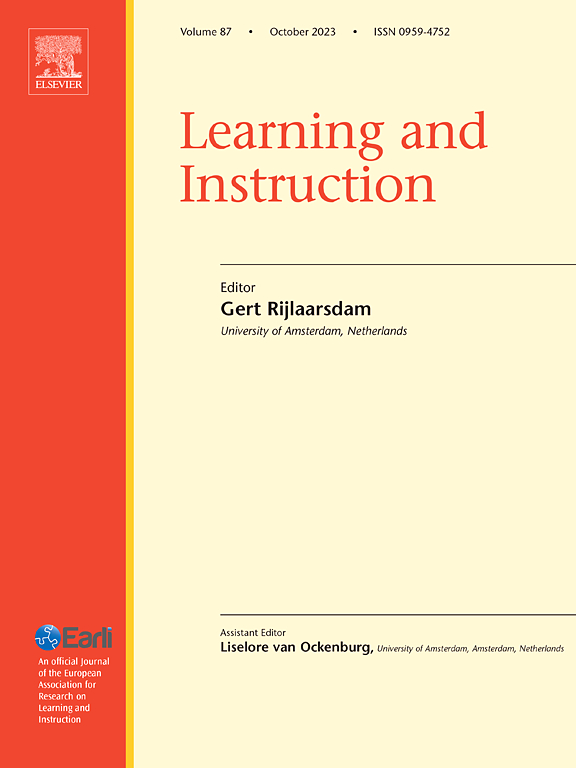幼儿工具创新的过程:对格式塔理论与感知-行动理论之间桥梁的尝试
IF 4.9
1区 教育学
Q1 EDUCATION & EDUCATIONAL RESEARCH
引用次数: 0
摘要
幼儿的工具创新是一个未被充分探讨的话题,格式塔理论和感知-行动理论对工具创新的过程提供了不同的解释。目的:设计9个工具创新任务,研究3- 6岁儿童的工具创新过程,并为任务的有效性提供证据。来自三所幼儿园的141名中国儿童(77名男孩和64名女孩)参与了这项研究。方法将儿童的任务表现编码为任务成功(是否获得奖励)和理想操作(是否执行某种操作),并将儿童的任务探索过程编码为固定(重复相同动作的频率)和灵活性(转向新动作的频率)。儿童的认知灵活性、工作记忆、抑制控制、发散思维和一般智力也被测量。结果新任务难度不同,具有较高的内部一致性,儿童的任务表现与年龄、一般智力和发散性思维的个体差异呈正相关。儿童的行为固定阻碍了他们的工具创新,这种影响在较容易的任务中得到加强。儿童的行为灵活性增强了他们的工具创新能力,而且这种影响似乎在难度任务中比在难度任务中更强。结论新任务稳健性强,适合幼儿工具创新研究。任务难度水平在儿童工具创新过程的形成中起着关键作用,它可能是解释工具创新过程的格式塔理论和感知-行动理论之间的桥梁。本文章由计算机程序翻译,如有差异,请以英文原文为准。
The process of tool innovation in young children: An attempt to bridge the Gestalt and the perception-action theories
Background
Tool innovation in young children is an underexplored topic, and the Gestalt and the perception-action theories offer different explanations regarding the process of tool innovation.
Aims
We aimed to develop nine tool innovation tasks to investigate the tool innovation process in 3-to 6-year-old children, while providing evidence on the validity of the tasks.
Sample
From three kindergartens, 141 Chinese children (77 boys and 64 girls) took part in this research.
Methods
Children's task performance was coded as task success (whether they retrieved the reward) and ideal manipulation (whether they performed a certain manipulation), and children's task exploration process was coded for fixation (the frequency of repeating the same actions) and flexibility (the frequency of shifting to novel actions). Children's cognitive flexibility, working memory, inhibitory control, divergent thinking, and general intelligence were also measured.
Results
The new tasks showed varied difficulty levels and exhibited high internal consistency, and children's task performance was positively associated with their individual differences in age, general intelligence, and divergent thinking. Children's behavioral fixation hinders their tool innovation, and this effect was strengthened for easier compared to harder tasks. Children's behavioral flexibility enhances their tool innovation, and this effect was seemingly stronger for harder compared to easier tasks.
Conclusions
The new tasks were robust and suitable for studying young children's tool innovation. Task difficulty level has a critical role in shaping children's tool innovation process, which may serve as a mechanism to bridge the Gestalt and the perception-action theories in explaining the process of tool innovation.
求助全文
通过发布文献求助,成功后即可免费获取论文全文。
去求助
来源期刊

Learning and Instruction
Multiple-
CiteScore
11.30
自引率
4.80%
发文量
109
期刊介绍:
As an international, multi-disciplinary, peer-refereed journal, Learning and Instruction provides a platform for the publication of the most advanced scientific research in the areas of learning, development, instruction and teaching. The journal welcomes original empirical investigations. The papers may represent a variety of theoretical perspectives and different methodological approaches. They may refer to any age level, from infants to adults and to a diversity of learning and instructional settings, from laboratory experiments to field studies. The major criteria in the review and the selection process concern the significance of the contribution to the area of learning and instruction, and the rigor of the study.
 求助内容:
求助内容: 应助结果提醒方式:
应助结果提醒方式:


